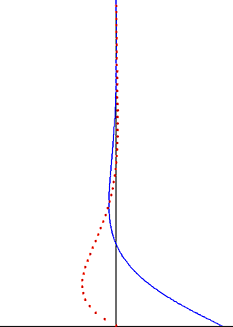Loading AI tools
From Wikipedia, the free encyclopedia
In fluid dynamics, Stokes problem also known as Stokes second problem or sometimes referred to as Stokes boundary layer or Oscillating boundary layer is a problem of determining the flow created by an oscillating solid surface, named after Sir George Stokes. This is considered one of the simplest unsteady problems that has an exact solution for the Navier–Stokes equations.[1][2] In turbulent flow, this is still named a Stokes boundary layer, but now one has to rely on experiments, numerical simulations or approximate methods in order to obtain useful information on the flow.

Consider an infinitely long plate which is oscillating with a velocity in the direction, which is located at in an infinite domain of fluid, where is the frequency of the oscillations. The incompressible Navier–Stokes equations reduce to
where is the kinematic viscosity. The pressure gradient does not enter into the problem. The initial, no-slip condition on the wall is
and the second boundary condition is due to the fact that the motion at is not felt at infinity. The flow is only due to the motion of the plate, there is no imposed pressure gradient.
The initial condition is not required because of periodicity. Since both the equation and the boundary conditions are linear, the velocity can be written as the real part of some complex function
because .
Substituting this into the partial differential equation reduces it to ordinary differential equation
with boundary conditions
The solution to the above problem is
The disturbance created by the oscillating plate travels as the transverse wave through the fluid, but it is highly damped by the exponential factor. The depth of penetration of this wave decreases with the frequency of the oscillation, but increases with the kinematic viscosity of the fluid.
The force per unit area exerted on the plate by the fluid is
There is a phase shift between the oscillation of the plate and the force created.
An important observation from Stokes' solution for the oscillating Stokes flow is that vorticity oscillations are confined to a thin boundary layer and damp exponentially when moving away from the wall.[7] This observation is also valid for the case of a turbulent boundary layer. Outside the Stokes boundary layer – which is often the bulk of the fluid volume – the vorticity oscillations may be neglected. To good approximation, the flow velocity oscillations are irrotational outside the boundary layer, and potential flow theory can be applied to the oscillatory part of the motion. This significantly simplifies the solution of these flow problems, and is often applied in the irrotational flow regions of sound waves and water waves.
If the fluid domain is bounded by an upper, stationary wall, located at a height , the flow velocity is given by
where .
Suppose the extent of the fluid domain be with representing a free surface. Then the solution as shown by Chia-Shun Yih in 1968[8] is given by
where

The case for an oscillating far-field flow, with the plate held at rest, can easily be constructed from the previous solution for an oscillating plate by using linear superposition of solutions. Consider a uniform velocity oscillation far away from the plate and a vanishing velocity at the plate . Unlike the stationary fluid in the original problem, the pressure gradient here at infinity must be a harmonic function of time. The solution is then given by
which is zero at the wall y = 0, corresponding with the no-slip condition for a wall at rest. This situation is often encountered in sound waves near a solid wall, or for the fluid motion near the sea bed in water waves. The vorticity, for the oscillating flow near a wall at rest, is equal to the vorticity in case of an oscillating plate but of opposite sign.
Consider an infinitely long cylinder of radius exhibiting torsional oscillation with angular velocity where is the frequency. Then the velocity approaches after the initial transient phase to[9]
where is the modified Bessel function of the second kind. This solution can be expressed with real argument[10] as:
where
and are Kelvin functions and is to the dimensionless oscillatory Reynolds number defined as , being the kinematic viscosity.
If the cylinder oscillates in the axial direction with velocity , then the velocity field is
where is the modified Bessel function of the second kind.
In the Couette flow, instead of the translational motion of one of the plate, an oscillation of one plane will be executed. If we have a bottom wall at rest at and the upper wall at is executing an oscillatory motion with velocity , then the velocity field is given by
The frictional force per unit area on the moving plane is and on the fixed plane is .
Seamless Wikipedia browsing. On steroids.
Every time you click a link to Wikipedia, Wiktionary or Wikiquote in your browser's search results, it will show the modern Wikiwand interface.
Wikiwand extension is a five stars, simple, with minimum permission required to keep your browsing private, safe and transparent.